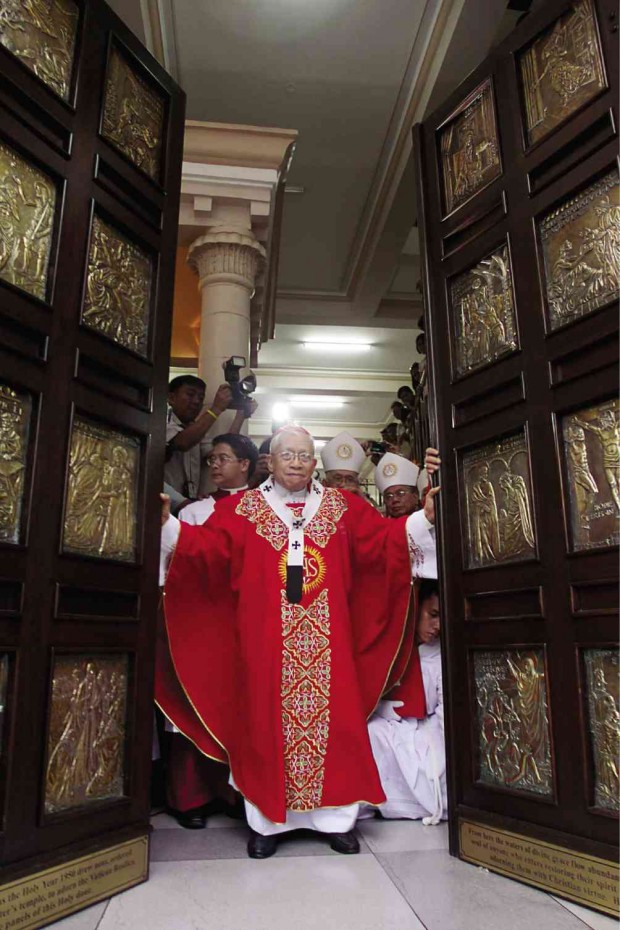For top church leader, IEC a journey of faith

Archbishop Ricardo Cardinal Vidal leads a Catholic Church ritual marking the Jubilee Year in the Cebu Metropolitan Cathedral.
Ricardo Vidal was 6 years old when he and other children received their first Communion the first time the International Eucharistic Congress (IEC) was held in the country in 1937.
Vidal later entered priesthood and rose to become a cardinal and head of the Cebu Archdiocese, the second biggest archdiocese in the country next to Manila.
Seventy-nine years later, the country is again host of the IEC, this time in Cebu City.
Now Cebu archbishop emeritus, Vidal would be at the other end of the Communion line. He would administer the sacrament to at least 5,000 children during Mass at the Cebu City Sports Center on Saturday.
Vidal, the most senior cardinal in the country, said he looked forward to the event with a mix of excitement and nostalgia.
Article continues after this advertisement“I would see a replica of what I experienced in 1937,” he said.
Article continues after this advertisementVidal recalled his thoughts as he received his first Communion at the 1937 IEC held at Rizal Park in Manila.
It was Vidal’s first time to set foot in Manila and the archbishop, a native of Mogpog, Marinduque province, remembered being amazed at the roads.
“In our town (Mogpog), only the sidewalk of well-to-do families was concreted and all of a sudden, I found all the roads in Manila were all covered with concrete. Then I said ‘all the people here must be rich,’” he said.
Vidal said it was his aunt, head catechist in their parish in Marinduque, who prepared him for the first Communion.
He also recalled seeing a cardinal for the first time.
“He was all dressed in red with a very long cape. I used to hold the cape of a reyna (queen) in our hometown fiesta. So my impression at that time was, ‘He was not only a priest dressed in red. He also looked like a reyna,’” the cardinal said, laughing.
Vidal said every first Communion is special since it’s the act of letting Jesus in your life for the first time.
“As Catholics, we believe that Christ is really present in the Eucharist—his body, blood, soul and divinity,” Vidal said.
One of those who would receive Communion from Vidal on Saturday, Marlon Lariosa, 11, said he was looking forward to the event.
A street urchin, Lariosa was recently introduced to the basic teachings of the Catholic Church by catechists.
He said he considered getting Communion an act of penance.
He said he used to throw stones at cars along the highway because he didn’t have any sense of what was right or wrong.
But learning about Christ changed his life.
Lariosa, of Barangay Sambag 2 in Cebu City, said he believed that his sins would be forgiven after receiving Communion.
Fr. Carmelo Diola said at least 500 street children, including Lariosa, would be among the 5,000 first communicants. The rest are pupils from different schools in Cebu.
Diola, IEC committee chair on solidarity and communion, said most of the street children are from Cebu City. A few are from the dioceses of Tacloban City in Leyte province, Tagbilaran City in Bohol province, Digos City in Davao del Sur province and Dumaguete City in Negros Oriental province.
Those from Cebu were selected through a survey by the Archdiocese of Cebu in the parishes to identify the poorest of the poor.
The Dilaab Foundation Inc., a nonprofit organization in the archdiocese of Cebu, and some private entities prepared the clothes that the street children would wear during the Communion—white polo shirts, black pants and black leather shoes for boys and white dresses and veils for girls.
Diola, also executive director of Dilaab Foundation, said the group made sure that the poor would have “dignified participation.”
“The spirit of the IEC is not to deny that they (the poor) are there. They will always be there and they should be part of the congress,” he said.
Diola said Church authorities teamed up with over 20 civil society groups and some parishes before giving street children an eight-session lesson about the Eucharist.
Reaching out to street children, he said, requires passion.
“We have to enter the world of street kids and give them quality formation. Even Pope Francis said that the worst discrimination the Church can have toward the poor is to give them poor religious formation,” Diola said.
This is not the first time Diola organized first Communion for indigent children.
Diola worked with the police and other agencies so street children would be acquainted with the teachings of the Catholic Church, receive Communion and go to school.
Since 2014, Dilaab facilitated the first Communion of at least 50 street children.